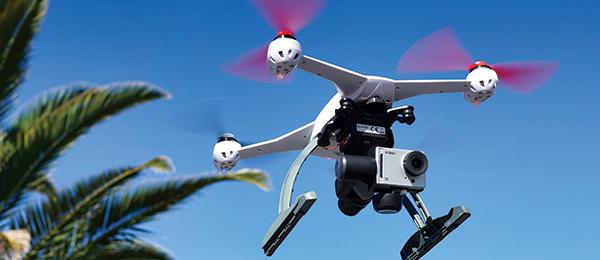Adding a webcam at your club field By Grant Schulte, Dan Fitzgerald, and Kevin Hyde [email protected] | Photos by the authors As seen in the December 2023 issue of Model Aviation. Anytime you want to see whether someone is flying at the Omahawks R/C Club’s field in Omaha, Nebraska, all you need to do is check the club’s website. Near the bottom of the homepage are two high-resolution photos. One offers an expansive view of the club’s pit area, pavilion, windsock, and runway. The other is a sweeping shot of the parking lot and access gate. Both images update automatically, once a minute. Check them out at the club’s website, listed in "Sources."

Setting Up
We installed both 4K cameras on a storage shed with mostly unobstructed views of the field. They’re attached beneath roof overhangs to provide additional protection from rain and to minimize their exposure to the sun. We also opted for cameras that can withstand Nebraska’s frigid, icy winters and ferocious summer heat. The cameras are hassle free, reliable, easy to maintain, and rugged enough to work in all kinds of weather.


Helpful Features
Both cameras are high-resolution, wide field-of-view outdoor models with a large operating temperature range and internet File Transfer Protocol (FTP) capabilities—essentially, they can move files from one location to another on the internet. The camera’s features allow us to influence the size of the image and how frequently they’re posted, which, in turn, lets the club control our bandwidth usage. The high-resolution photos give club members the option to zoom in when it is desired to see additional details. Simply refreshing the club’s website displays the most recent image. Both cameras rely on a Power Over Ethernet (POE) switch that serves as both an electrical and data connection. The cameras are hooked to the switch through outdoor-rated ethernet cables. The switch, in turn, is linked to the mobile router, which connects to the internet over our provider’s cellular network.
What You Need
Creating an outdoor webcam requires an up-front investment that we believe was well worth it. Following is a list of everything we purchased for a solid, reliable setup with high-quality images:- Axis Communications M2036-LE 4MP Outdoor Network Bullet Camera: $429
- SanDisk 32GB Extreme microSDHC UHS-I memory card: $11.89
- Netgear Nighthawk M1 MR1100 4G LTE Mobile Router (T-Mobile): $429.99
- Proxicast Ultra Low Profile MIMO 4G / LTE Omni-Directional 2.5 dBi puck
- Magnetic/Adhesive Mount Antenna for TS9 connector: $54.95
- Netgear 5 Port PoE Gigabit Ethernet Plus switch (GS305EP): $64.99
- Outdoor 25-foot, Cat7 outdoor ethernet cable: $12.99
- Basic internet service: $30-$40 per month
Internet
To improve cellular reception for internet service, we mounted an adhesive puck cellular antenna to the outside of the metal shed. For internet access, we first considered asking a local provider to lay a cable to our field, but that would have been very expensive because there were no other potential users to share the cost. That left satellite or cellular service. Satellite service costs roughly $50 a month and was based on availability in the area. Our club was reluctant to explore it because no one had any experience with it. So, we examined Verizon and AT&T cellular plans. Verizon had data-only plans but only offered Wi-Fi modems. For simplicity, we needed a mobile router that could connect to the cameras through the POE switch. Fortunately, AT&T offered a Netgear Nighthawk LTE Mobile hotspot router that met our requirements. The prepaid, data-only plan provides 10 gigabytes of 5G service for $30 per month or 30 gigabytes for $40 a month. We’ve found that 10 gigabytes is plenty for most of the year. However, we did exceed 10 gigabytes one month in the winter, so we increased our plan to 30 gigabytes and chose to refresh images more often. At first, it was one new image every five minutes, and then one every three minutes. We eventually moved to one image per minute from both cameras, which uses approximately 1 gigabyte per day (roughly 30 gigabytes per month). We’re watching our data usage again to determine whether we want to reduce the capture rate. Obviously, the rate doubled when the club added a second camera. To update photos, we set up the cameras to send images to the club’s website using the FTP internet protocol. New images replace the previous ones, ensuring that only the most recent image is displayed on the website and that we don’t use too much server storage space. The cameras also record 10-minute videos that are saved on a microSD card for six months. Posting or streaming full videos on our website wasn’t practical because of cell bandwidth limitations and cost, but it does allow us to review videos of the flying field in case there is ever an incident.A Strong Website
For our website, we turned to DualRates, a web provider with an easy-to-use interface that specializes in serving RC clubs. The DualRates website gives us many useful features through a simple interface without the need for complicated tools or the knowledge of programming languages. Its comprehensive services also help us distribute our monthly newsletter, track membership information, and process member payments. When we contacted DualRates, they helped establish the FTP protocol connection and a front-page photo link on our homepage that shows our camera’s latest image. The Omahawks camera refreshes photos around the clock, but the setup can be adjusted so that photos are only updated during the day. A super high-speed internet connection isn’t necessary. Ours uses a connection roughly equivalent to phone internet.










Comments
Add new comment